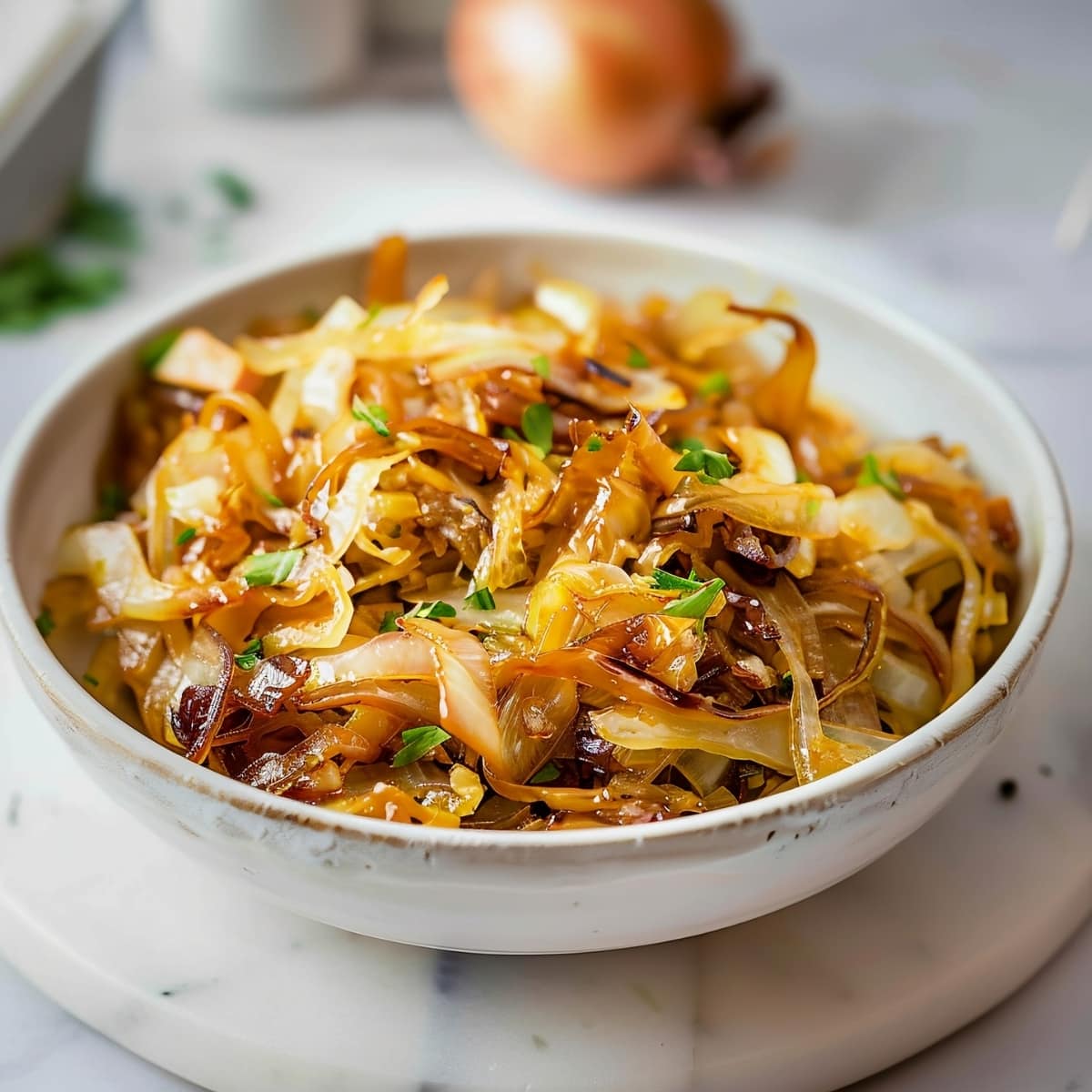Caramelized cabbage is a delectable side dish that transforms humble cabbage into a savory delight. You slowly cook thinly sliced cabbage in oil until it’s golden brown.
The natural sugars in the cabbage caramelize, creating a rich, flavorful dish. It has the perfect balance of sweetness and earthy undertones.

Why You’ll Love This Caramelized Cabbage Recipe
Caramelized cabbage is the perfect St. Patrick’s Day dish. It also works well for non-holiday occasions. Here are three reasons you’ll love it:
- It’s easy to make. You only need a few ingredients, and most are seasonings. The dish also comes together easily in less than 30 minutes.
- It’s full of flavor. Cabbage has a rich natural flavor of its own. Pair it with onions, herbs, and apple cider vinegar for a flavor explosion.
- It’s customizable. You can add other veggies or swap up the seasonings. You can also turn the dish into a hearty meal by adding a protein of your choice.
Ingredients
You need the following ingredients to make caramelized cabbage:
- Cabbage – While you can make this recipe with red cabbage, I prefer green. Select a medium-sized head with few to no blemishes or dark spots.
- Olive oil – For cooking and caramelizing the cabbage. Extra virgin oil works best.
- Onion – Use one medium onion. I typically use white or yellow onions, but a red one would also suffice.
- Dried thyme – Thyme provides a nice, earthy flavor that really sets off the cabbage.
- Salt & pepper – For seasoning.
- Brown sugar – Don’t worry. The sugar won’t make your cabbage sweet. You won’t add enough of it. You sprinkle it over the cabbage to help it caramelize better.
- Butter – Stir it in at the end for a fuller, richer flavor.
- Apple cider vinegar – It adds a nice tanginess that really brightens the mostly earthy dish.
- Fresh herbs – I recommend using parsley or dill, but you can experiment.
- Greek yogurt & lemon juice – These are optional ingredients for serving. However, like the apple cider vinegar, they really lighten and brighten the dish.

How to Make Caramelized Cabbage
Making caramelized cabbage isn’t nearly as difficult as you might think. Simply follow these steps:
1. Prepare the cabbage. Remove the outer leaves. Then, cut the cabbage into quarters and then into 1/2-inch strips. Trash the core. Thinly slice the onion, as well.
2. Cook the veggies. Heat the olive oil in a large skillet over medium heat. Then, add the onion slices and cook them until they soften. (About 5 minutes.)
Finally, add the cabbage strips. Season them with the thyme, salt, and pepper, and add the brown sugar to help caramelize them.
Cook for 10 to 15 minutes, stirring occasionally.
3. Add the butter and vinegar. Once the cabbage has caramelized, add the butter. Stir gently and cook for another 2 minutes.
Next, pour in the apple cider vinegar. Use it to scrape up any stuck-on browned bits from the pan.
4. Finish the dish. Do a taste test and adjust the seasonings if necessary. Then, remove the pan from the heat and transfer the cabbage to serving dishes.
Top with fresh herbs, Greek yogurt, and lemon juice (if using). Enjoy!

Recipe Tips & Variations
Here are a few tips, tricks, and variations to keep in mind:
- Be even with the veggies. You want the onion slices and cabbage slices to be as uniform in size as possible. This will help them cook more evenly.
- Stir carefully! Don’t stir immediately after adding the cabbage. Give it time to caramelize on the bottom first. After that, though, stir frequently to avoid burning.
- Make it colorful. Use red cabbage instead. It provides a pop of color and a slightly sweeter flavor.
- Spice it up. Add a pinch of red pepper flakes or a dash of cayenne.
- Make it a meal. Add cooked protein, such as crumbled sausage, chopped bacon, or shredded chicken.
- Add extra crunch. About 2 minutes before finishing the dish, toss in a handful of your favorite nuts. Roasted sesame seeds also work well.

How to Store & Reheat
Here are storage tips to keep leftover cabbage fresh:
- To Store: Let the cabbage cool completely, then transfer to an air-tight container. Refrigerate for up to 3 days.
- To Freeze: Ensure the container is air-tight and freezer-safe. Freeze the leftovers for up to 1 month.
- To Reheat: It doesn’t matter if the leftovers are chilled or frozen. You don’t have to let them defrost before reheating them. Simply toss them in a pan with some water and cook over medium-low heat until warm.
What to Serve with Caramelized Cabbage and Onions
Caramelized cabbage makes an excellent side dish for most meals. Try it with any of the following:










